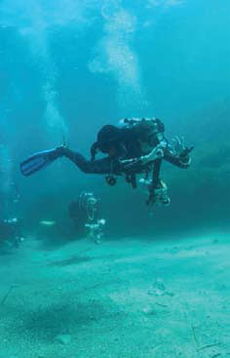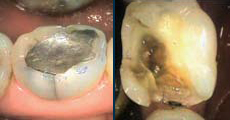




| Home | Features | Club Nights | Underwater Pics | Feedback | Non-Celebrity Diver | Events | 8 August 2025 |
| Blog | Archive | Medical FAQs | Competitions | Travel Offers | The Crew | Contact Us | MDC | LDC |

|

|
 
 |
 |
ISSUE 8 ARCHIVE - DIVING DENTISTCelehte FortuinI am going for professional help. My patients deserve it, my friends are begging me for it, my colleagues are giving me strange looks (although this is a normal day-to-day occurrence, but still...) and my buddy keeps on threatening to turn my air off during dives. Actually, there are two of them who keep telling me they will. Maybe there's more out there. I wonder if it's something I said? It couldn't possibly be linked to their last dental visit? Now, I am not paranoid by nature, but I also don't think installing CCTV, patting down everyone within arm's reach and turning into the Spanish Inquisition when anyone enquires how my day went, is considered polite or sane, to say the least. I'm pretty sure I haven't lost the plot yet, but if I were to say Steve Martin – Little Shop of Horrors: "...and that's why I became a deeeeennntist"! Get my drift? And by professional help I don't mean a head shrink... I know people who know people... You're right, that didn't go anywhere, but I thought I should share.So, where were we? Oh yeah, back in the real world. Much like in medicine, if we listen closely to patients' complaints and symptoms, they will often tell us the diagnosis. This will hopefully lead us to some sort of heroic intervention, swaying our dental tools, doing a Lara Croft impression and saving the dive (or day), followed, of course, by the widely misconceived notion of a wallet biopsy at the end of treatment. The more grateful the patient, the bigger the biopsy, the lighter the wallet. Naturally. So when a patient came in not so long ago complaining of a possible cracked tooth disturbing him whilst diving, I naturally suspected a cracked tooth. And you thought dentistry was hard! |
 |
 |
Cue patient X. Oh yes people, they
actually allowed me to see one! This
brave and wise man came to see me
about three weeks before his dive
holiday to sort this out. This is his story:
"On my last few dive holidays I have experienced pain from a certain lower left tooth. The pain always started a third of the way into the dive, typically the deepest part in the dive profile, lingered for a while, and then slowly went away. Either I got used to it or it really disappeared, but it was never enough to bin the dive. Descents, ascents and safety stops were all pain-free. The tooth is sensitive and a little weird and tender when I touch it now. I have an old silver filling on this tooth and asked my dentist whether there was a crack or something similarly sinister about this tooth. But nothing was visible. The pain has slowly gotten worse on subsequent dives and I am worried it may stop me diving." |
 |
|
When is a crack not a crack and when
will it start hurting if it is? The grooves
in our teeth are great for catching
food and drink stains, becoming
discoloured over time. Some grooves
extend around the sides of the tooth
pretending to be cracks. On other
occasions a true crack exists but
cannot be seen directly with the naked
eye. It could be that it has not become
discoloured yet or needs some special
effects lighting to expose it.
Looking at the offending tooth, it was clearly not a groove in drag, but a definite crack. Stained to the hilt, dressed up and on show for all to see (stop sniggering in the back). Upon removing the old filling, two further hairline fractures in the depths of the tooth became visible and the fractured side of the tooth came away of its own accord. After refilling the tooth, the patient went on holiday and, Hey Presto, no more pain on diving. I know this because he came back. I am sure I would also have known if the tooth wasn't OK after his holiday, yikes! The hairline fracture had allowed for compressed air and bubbles to migrate into the tooth, staying there for the deepest part of the dive, exerting pressure on the filling and tooth, transferring it to the nerve. Because of the slow and gradual ascent, the pressure eased off as the bubbles migrated back out of the tooth again, allowing the pain to subside and not cause any problems on the safety stops. However, the length of time the tooth went untreated and the repeated exposure of the fractures to the effects of pressure, resulted in this tooth becoming more and more painful. So trust yourselves guys, if something doesn't feel right with a tooth on diving, get it sorted way before your next dive. Give yourself and the dentist enough time to allow for all eventualities, just in case more treatment is required to settle the tooth. I'm thinking root canal treatment... anyone shaking in their booties yet? I thought I would finish off with some useful hints and tips that I know for a fact my housemates could never have done without before they knew me:
That's it, I'm out of here! Happy flossing! Celehte can normally be found singing her way through the day at her Fulham practise. Any questions or queries can be sent here or you can call Fulham Dental Care on 020 7610 9400. |
 | |
Previous article « Practical Guide to The Scilly Isles Next article » Paul Toomer: Agony Aunt Back to Issue 8 Index | ||